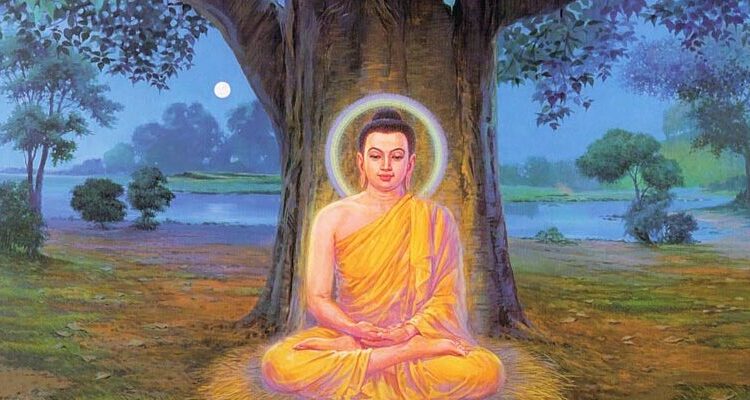During the time of the Buddha, there were two popular ways of living in India. Those two were based on two separate ways of thinking. According to one of these ways, a man’s body and soul will be gone forever after death. Therefore, one must enjoy the life to the fullest. This way of thinking was called ‘Kamasukallikanuyoga’ [self–indulgence]. The philosophy associated with ‘Kamasukallikanuyog’a was based on ‘Ucchedavāda’. The Buddha called it an ignoble, useless and unworthy practice and completely rejected it.
The other way of life was that, even though the body is destroyed after death, the soul survives and will continue to travel through ‘samsara’. ‘Attakilamathanuyoga’ [self-mortification] which was a practice of torturing the body by was followed by those who accepted the views of ‘shāswathawāda’. The Buddha rejected this too by saying, that this is ignoble and futile.
After discarding these two forms of life, a new form of life had to be presented instead. The Buddha’s first sermon ‘Dhammacakkapavattana Sutta’ which introduces the ‘Middle Path’ describes a ‘sammā ājīva’ [moral living] as the fifth aspect.
Since it seems to raise misconceptions, it should be emphasized here that ‘The Middle Path’ is not constructed by adding the rejected ends. This practice is based on a new view of man and the world. This new philosophy which was understood by the Buddha during his enlightenment was introduced as ‘Paticcasamuppāda’.
In order to understand ‘The Middle Path’, which means ‘the balanced way of life’ in the truest sense of the word, there must be some understanding of ‘Paticcasamuppāda’. The word ‘Paticcasamuppāda’ is formed using the words ‘paticca’ and ‘samuppāda’. ‘Paticca’ means ‘cause’ ‘samuppada’ means ‘effect’. Therefore, ‘Paticcasamuppada’ means occurred because of. This term is a good expression of the philosophy presented by that word [The Most Ven. Katukurunde Gnananda Thero has used this word].
At the beginning of the introduction of the theory of ‘Paticcasamuppāda’ it is shown that “When there is this that is, with arising of this that arises; when there is not this that is not, with the cessation of this that ceases”: “Imasmim sati idam hōti, imassa uppādā idam uppajjāti; imasmim asati idam na hōti”.
Because of ignorance, people who think there is a sentient living in the world are sentient beings. They, who have grasped the extreme ends and got caught by the self-view are leading an unbalanced life. The theory of ‘Paticcasamuppada’ sets the sentient beings free from self-deception and extremism and brings them to a balanced lifestyle. This is how a balanced way of life is created by the central concept of the entire Buddha Dhamma. Every Buddhist teaching is built on this philosophy.
If a man is not a sentient unit and his life is inextricably linked with the society and environment around him, correct and good behaviour is an activity that gives good results to oneself and to society as well. That is a lifestyle which benefits the self and the society too “attahita-parahita”. It is the moral principles revealed in the ‘Ambalaṭṭhikarāhulovādasutta’.
‘Singālowāda Sutta’ emphasizes the social relations among various members of a society based on these moral ethics.
It is also in accordance with this dhamma that the ‘Andha Sutta’ advises us to be perceptive when handling economic problems. By emphasizing that, the ‘Vyagghapajja Sutta samajeevikathā’ has shown that the income and expenditure of a government should be balanced. ‘Paththakamma Sutta’ describes that consumption should be managed. ‘Sathara Sangraha Wasthu’ [a ruler has four ways of treating the community], Brahma- Vihara: ‘Metta’ [loving kindness]; ‘Karuna’ [Compassion], ‘Muditha’ [sympathetic joy] and ‘Upekka’ [equanimity] are moral codes introduced emphasize these two extremes.
The relationships and interconnections of each and every aspect of human life were considered when preparing all the teaching scattered in the ‘Tripitaka’ and other religious texts. A balanced life which is peaceful and pleasant is , free from prejudice and extreme divisions, and does not create problems for society or the individual.
Today, why must we emphasize this balanced way of life? Because our lifestyles have initiated many problems in the world, the country, society and family. Also, the economy to has been unable to make people satisfied, and everyone is dissatisfied. How did this unbalanced lifestyle spread across the world?
The philosophy which came up with the unbalanced lifestyle is a gift of the Western world. Professor Kalupahana has excellently pointed it out in his published work ‘Ethics in Early Buddhism’.
Accordingly, it is the theory known in the western world that any act accompanied selfishness is not able to be ethically evaluated. The economy is the fulfilment of selfish goals. Therefore, morality should be kept separate from the economy. Western economic policies were built on the advice of religious experts such as Jhon Maynard Keynes who accepted this view.
In 1930, British economist E. N. Schumacher, in his book ‘Small is beautiful’, has argued that even if ethics are needed, that should be kept away from economics for another hundred years. In less than a century, it has been seen that the economic policies which accepted these teachings have spread all over the world.
It can be said without a doubt that this is the primary cause for all the problems, dissatisfactions and instability that has currently being aroused in the world. It is undeniable that, this unbalanced lifestyle could be changed into a moral lifestyle only through the guidance given in the ‘Tripitaka’ using the ‘Middle Path’.

